Africa – one of the most exciting and diverse continents on earth. Today, travel reporter Tine takes you on a breathtaking Botswana tour. Tine lives in South Africa, shows friends and visitors the country, and also loves traveling to the surrounding countries. Whether Malawi, Zimbabwe, Namibia, Mozambique, or even Botswana – she loves adventure and, above all, the African wilderness. In today’s travel report, Tine talks about the real Africa, about her nights amidst the vastness of Botswana and her encounters with hyenas, giraffes, buffalo, elephants, jackals, and many other inhabitants of the African savannah.
What else you should know
- What else you should know
- Me and my love for Africa
- Preparation and planning
- Safety in the country
- Entering Botswana
- Best time to travel for your Botswana tour
- Road conditions
- Malaria in Botswana
- Start of my Botswana tour
- Elephant Sands in Nata
- The Makgadikgadi Pans
- Okavango Delta
- Overnight in the wilderness
- Drive through the Moremi Game Reserve
- The Dqae Qare San Lodge
- Saying goodbye in Windhoek
- Camping and Camping
- Costs for the Botswana tour
- Packing list for my Botswana tour
- Conclusion of the Botswana tour
Me and my love for Africa
I’m on the beach as often as possible, try surfing and diving, am in the mountains almost every day, and live the German dream of an expat in South Africa. Sometimes several times a month, I show friends and visitors the country, mostly focusing on the Garden Route. But I mostly stayed in the same accommodations, the same restaurants, and hiked the same coastal routes. You want to show people the most beautiful spots.
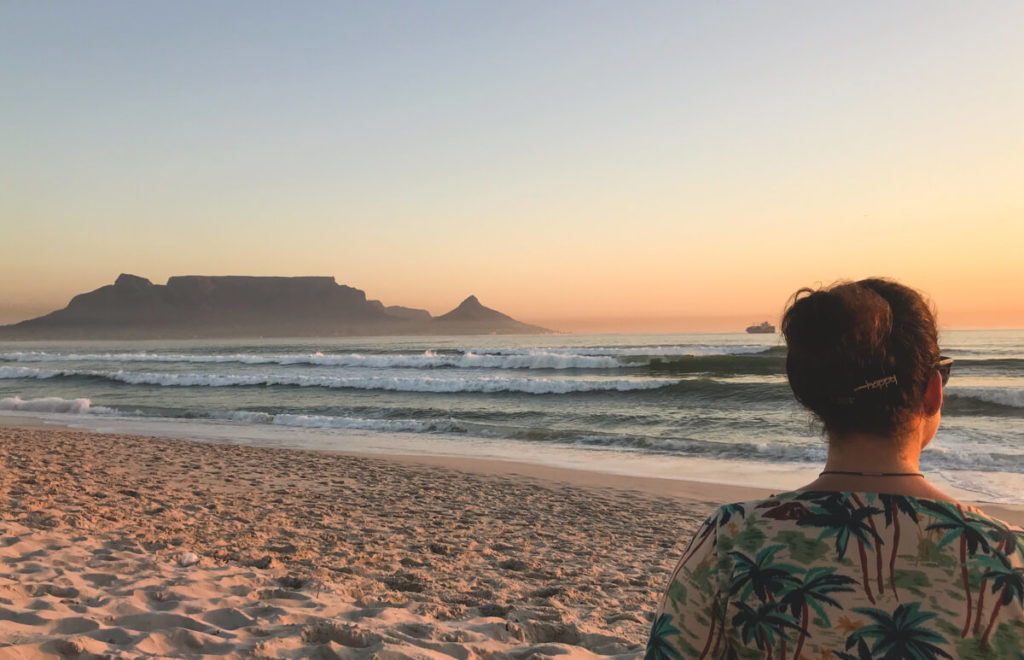
It wasn’t until this year that I dared to open my eyes a little more. Why had I never been to South Africa’s neighboring countries? Of course, it’s always a question of budget, because sometimes it’s cheaper to fly to Europe than to one of the neighboring countries. In January, however, I was lucky and found a cheap flight, and so I went to Zimbabwe for three to four weeks on a one-way ticket to Victoria Falls. From there, I traveled as far as Malawi. Barely back home in Cape Town, I traveled to Mozambique for a few days. Just three months later, I ventured on my first trip to Namibia.
Every day, mainly German, but also other European tourists, land in Cape Town, rent the biggest cars with roof tents, and head north to explore Namibia or Botswana. This isn’t my style of travel, but I do have a bit of respect or fear about traveling through Namibia alone with my small car and a small tent. Fortunately, I was proven wrong, because this is one of the best ways to explore Namibia.
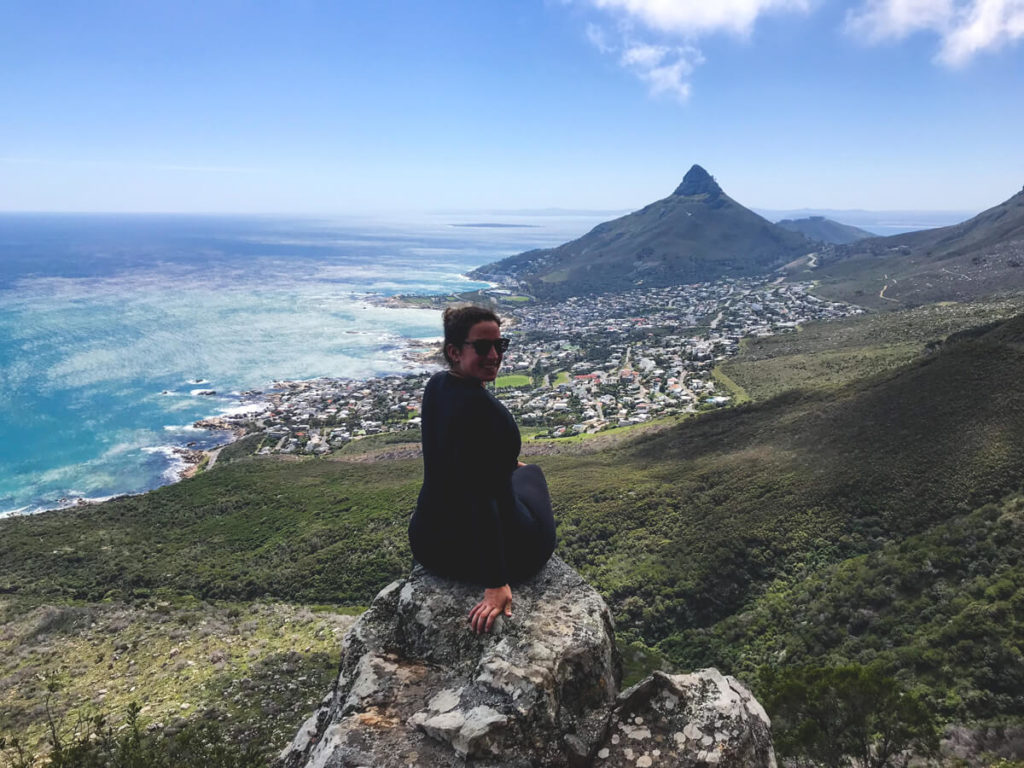
In October 2019, I fulfilled another dream. After I had already taken a day trip from Livingston to Chobe National Park, Botswana, I was captivated by the wilderness of Botswana. Nowhere else can the animals roam so freely, nowhere else can you live in true African wilderness.
Preparation and Planning
Unfortunately, Botswana is considered one of the most expensive countries in Africa. A flight or driving my own car was therefore out of the question. Overnight stays in lodges, hotels, and hostels were also out of the question, as you’d usually have to spend several hundred dollars on a tour. On a rainy “I’d rather stay in bed all day” day in Cape Town, an opportunity suddenly popped up. Many travelers, especially solo travelers, have the same problem. Various Facebook travel groups are looking for rides. That’s exactly where I found a couple who wanted to travel from Johannesburg through Botswana to Windhoek.

It became even more perfect when they told me they already had camping equipment on board, so I could fly to Johannesburg with basic hand luggage. They even found a fourth person, making it the perfect number for a leisurely long road trip. If you’re not so lucky or already have a group, you can easily rent a car in Johannesburg. You can either rent camping gear or buy it cheaply and resell it at the end of your trip. There are also guided tours, of course, but these are considerably more expensive.
Security in the Country
Botswana’s politics and currency are relatively stable. The country, which only declared independence in 1966, experienced an economic boom thanks to state-controlled and corruption-free diamond mining and is now one of the richest, most stable, and most peaceful countries in Africa. I also always felt safe.
We sometimes left our car’s unlocked trailer unattended in front of supermarkets. However, be careful not to leave valuables in the car; opportunity makes thieves. In Botswana, the police are respected, and if someone misbehaves, severe consequences await. At 18%, the unemployment rate is lower than that of neighboring countries.
Entering Botswana
Entry as a German citizen is straightforward. You receive a stamp upon entry and a 90-day residence permit. Rural border crossings are generally stress-free, but you can experience longer wait times. We were usually at the border at midday, which sometimes meant that most officials were on their lunch break. It’s also important to know that fresh food isn’t allowed to be imported. So make sure you buy the basics in South Africa; meat, dairy products, and the like in Botswana.
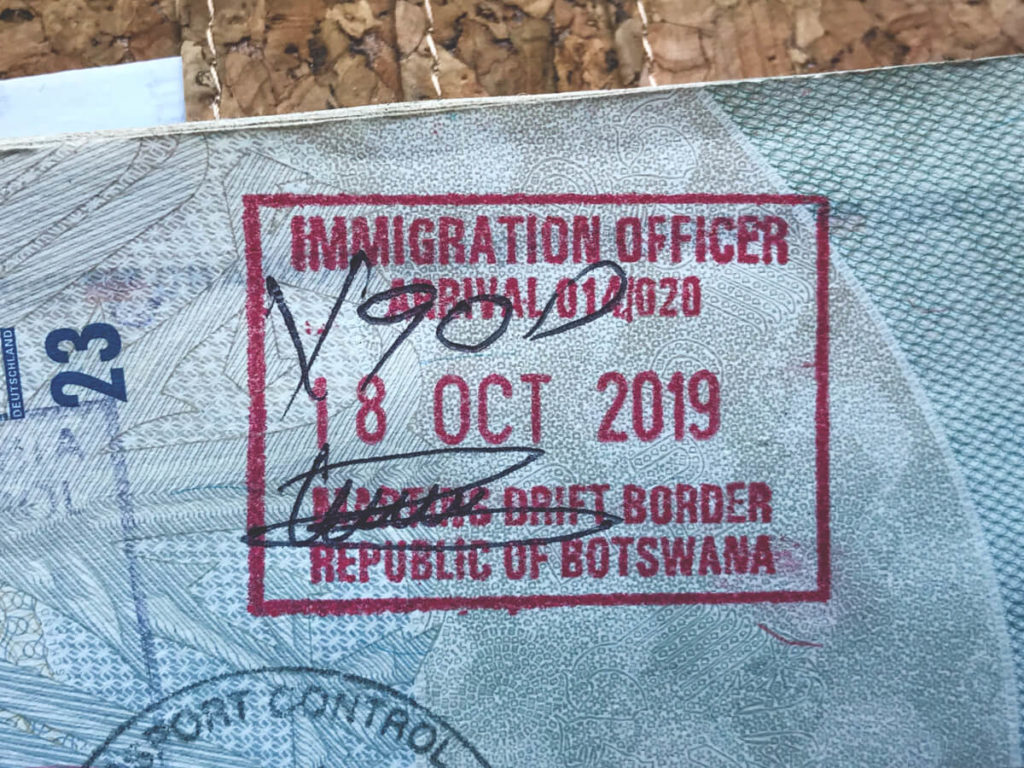
If you enjoy a glass of wine in the evening, you can buy it more cheaply in South Africa. Since foot-and-mouth disease is still endemic in Botswana, there are additional checks at various border posts throughout the country. These then confiscate fresh meat and sometimes dairy products as well. Grilled meat, however, is permitted. This is intended to protect cattle ranches in the south from diseases affecting wild animals in the north, and vice versa.
Unfortunately, drones are also not permitted. Weapons, even hunting weapons, are subject to certain restrictions, as hunting is not permitted in Botswana. There are additional fees for entering the country by car. We paid $60 for the car and $35 for the trailer. As far as I know, this depends on the size and weight of the car.
Best time to travel for your Botswana tour
The time to travel… That’s always a tricky thing. I love traveling in the off-season, as accommodations and activities are much cheaper. In itself, every season is a good season in Africa. A distinction is made between the rainy season and the dry season. During the rainy season, everything is beautifully green, and every road trip becomes a slippery adventure. Some lodges (especially in the Okavango Delta) close for several weeks.
The rainy season begins in October (although I didn’t see a single drop in my 10 days) and ends in April. The later you travel in the rainy season, the more water there is in the delta, in the waterfalls, and on the roads. During the dry season, the chances of spotting wildlife are considerably higher. The animals stay near the few water sources that still exist in the north. Nature transforms from a rainforest into a desert-like and dreary landscape. Only in the Okavango Delta can you still find a little “green.”
Road Conditions
The roads in Botswana are everywhere and nowhere. There’s a paved circular route and countless gravel roads, some with potholes where you could swim. A 4×4 is almost a must, as otherwise, parks like the Moremi Game Reserve or the Okavango Delta in general cannot be reached. You have to be careful on the salt pans; you can get lost very quickly.

If it’s wet or raining, the pans are impassable, and if you’re stuck in the middle of them, it can take days to find a dry way out. Wildlife is primarily found in the north of Botswana, but we also saw elephants and giraffes further south. Particular caution is required here. Therefore, you should avoid driving at night or in the dark if possible. Fuel stops should be planned carefully, as there is hardly any infrastructure and the distances are very long.
Malaria in Botswana
Still an issue. If you’re worried about malaria, it’s best to take tablets like Malerone or something similar. During the dry season, there are hardly any mosquitoes. I usually travel with a malaria test kit (available at any pharmacy in South Africa) and mosquito spray. However, everyone should thoroughly research this topic and definitely consult a tropical medicine specialist.
Start of my Botswana tour
We started our Botswana tour in Johannesburg. From there, we drove to Pilanesberg and camped for two nights at the Manyane Camp Site. The park is beautiful, and the campsite is ideal for getting into wildlife camping, as there are some very curious kudus that like to peek into your tent at night.
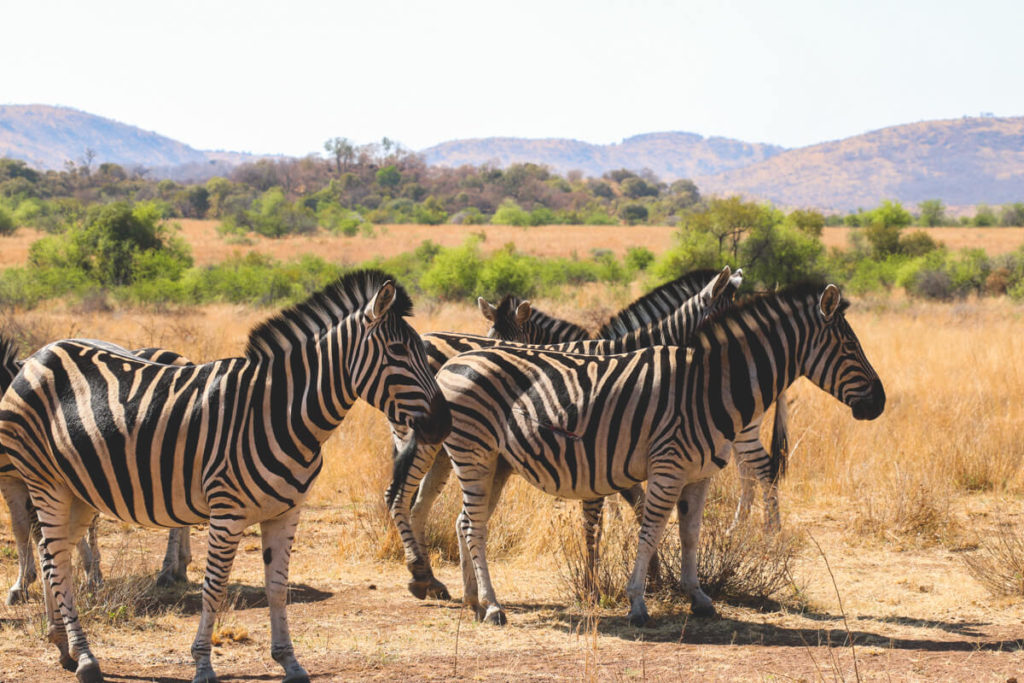
Elephant Sands in Nata
On the third day, we crossed the border into Botswana and had a relatively long drive ahead of us beyond Nata. We stayed overnight at Elephant Sands, a truly unique experience. The owner once found a baby elephant without its mother when he was younger and raised it. His water source is the only one within a 60km radius during the dry season. This means that dozens of elephants roam the center of the camp both day and night (water is pumped for the elephants from 11 a.m. to 11 p.m.). Initially, he only planned a small camp for friends and family, but now you can camp at the waterhole and even sleep in a chalet.

The Makgadikgadi Pans
From there, we drove into the salt pan for one night. The Makgadikgadi Pans and the Nwetwe Pans form a vast salt landscape where it’s easy to get lost. We wild camped and saw one of the most beautiful sunsets. We slept without tents, directly under the stars. You could hear the jackals around you, but none of the animals came very close to us. If that’s too adventurous for you, you can also stay at one of the surrounding campsites. Planet Baobab has beautiful baobab trees, Wi-Fi, a bar, and a pool (which can be quite pleasant at 45 degrees Celsius).
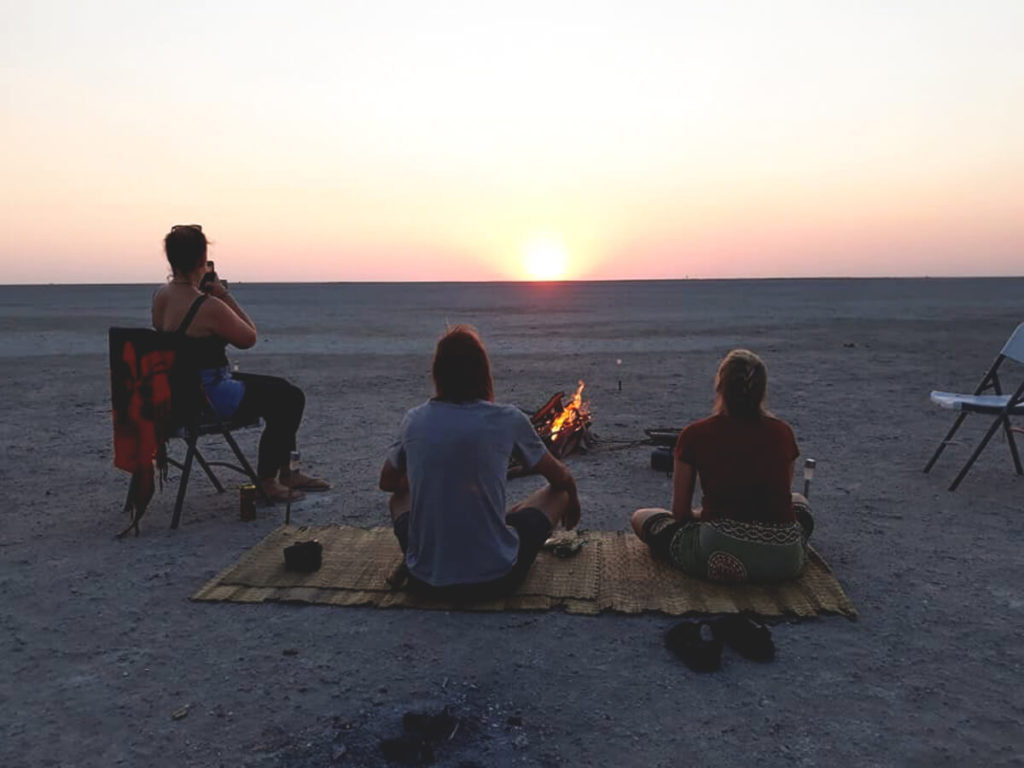
Okavango Delta
Then the real adventure began: Okavango Delta. Unfortunately, there wasn’t much water at the time of my trip, so only a few small streams were visible. We were told that the famous mokoro canoes hadn’t been on the water for eight months. Therefore, we had to be extra cautious, as the animals come much closer to the camps in an emergency. We spent our first night at Mogogelo Camp/Kaziikini Camp, on the way to Moremi South Gate. There’s also a watering hole there, which can be observed from the camp or the restaurant.
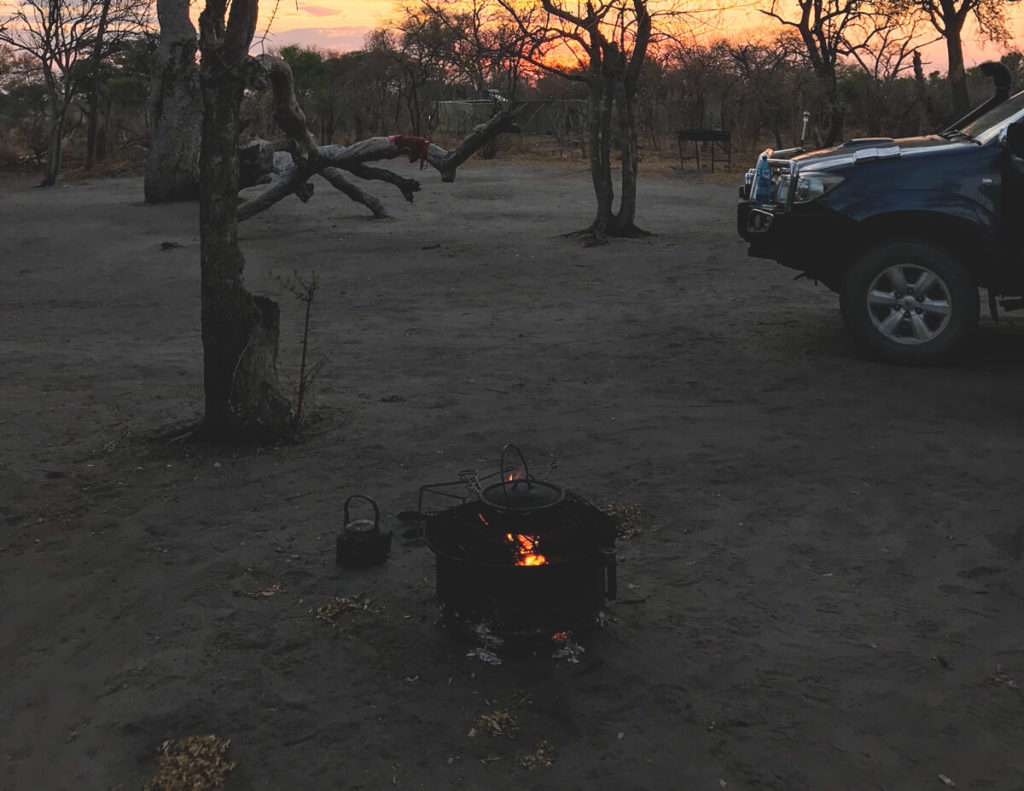
It’s best to prepare dinner well in advance, as hyenas might otherwise join you. It’s best to sit in a circle with flashlights so you can watch each other’s backs. Hyenas love the element of surprise, but as soon as you “catch” them, they lose interest, turn around, and seemingly trot away. While shining a light on the trees, we saw countless bush babies. We were also lucky enough to see two porcupines and a honey badger. Luckily, the hyenas stayed a bit further away from us.
Overnight in the Wilderness
There’s cracking and crashing everywhere. I’m not sure if it’s an animal or the guy in the tent next to me. Why am I camping in the African bush again? Oh yeah, testing boundaries, pushing the boundaries, expanding the comfort zone… Just two weeks ago, I was panicking about jackals while camping in the Karoo in South Africa; this is definitely next level. In my panic, I built a barrier around my head and feet in the tent. It doesn’t help, but it does make you feel a lot safer. At some point, I fall asleep and am woken up by a noise that sounds like something is climbing the camping table next to me. Then it’s quiet again.
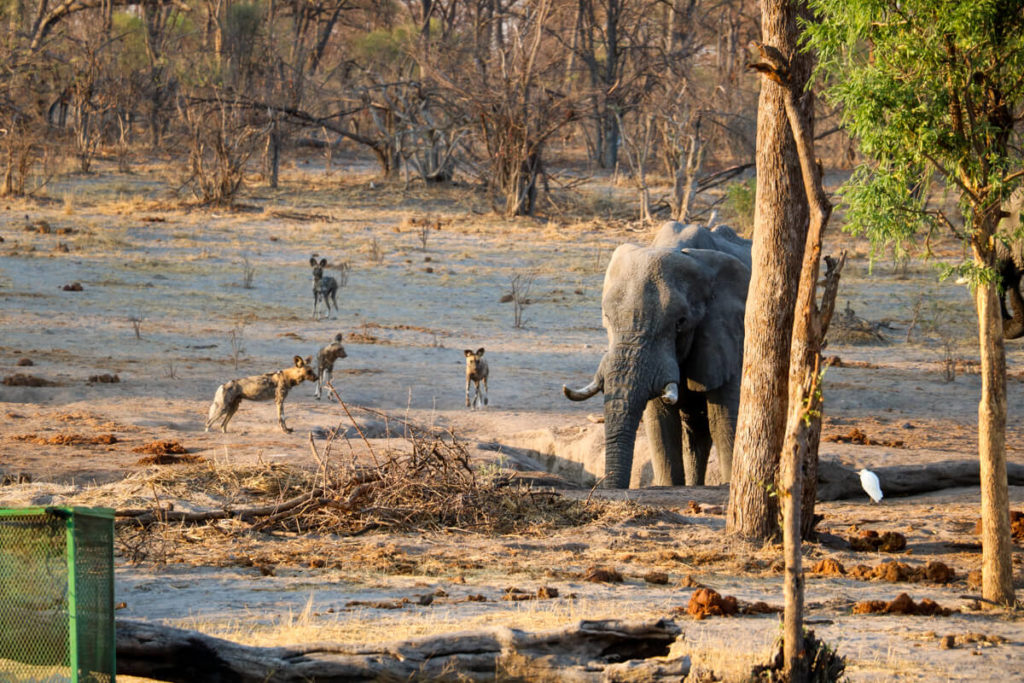
Unfortunately, our night camera didn’t work, so I still don’t know what was trying to climb up the table. In the morning, all the exertions of the night were forgotten, and I was even somewhat well-rested. Before breakfast, a group of 8-9 wild dogs came to the water source, and after breakfast, an entire family of elephants walked through our camp to get to the water source. Wonderful, what a privilege to experience that. My panic from last night seems almost ridiculous, but hey, everyone starts small in the bush.
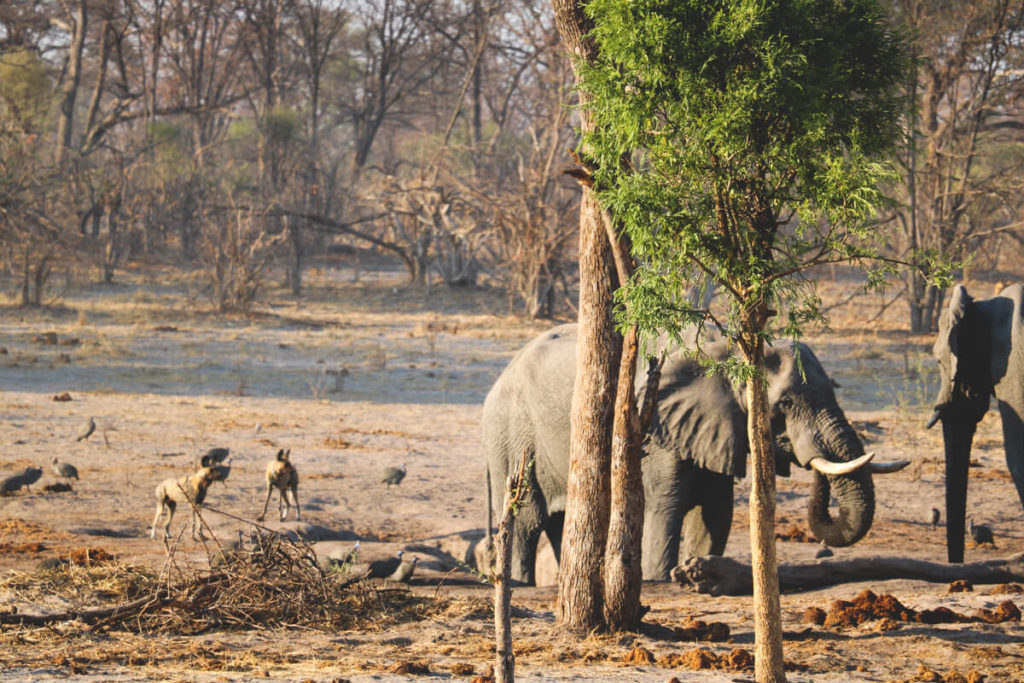
Drive through the Moremi Game Reserve
During the day, we drive along the river in the Moremi Game Reserve. Hundreds of elephants, zebras, impalas, giraffes, buffalo, and all kinds of other animals frolic around the small stream, the last remaining trickle of the great delta. We eat chip sandwiches for lunch (you absolutely have to try them, they’re not bad), duel with elephants for the right of way, and enjoy every lilac-breathed roller we can find. In the evening, it’s the same game. Everyone has each other’s backs. A fire in the middle, red wine in the right hand, and boerewors in the left. A dream!
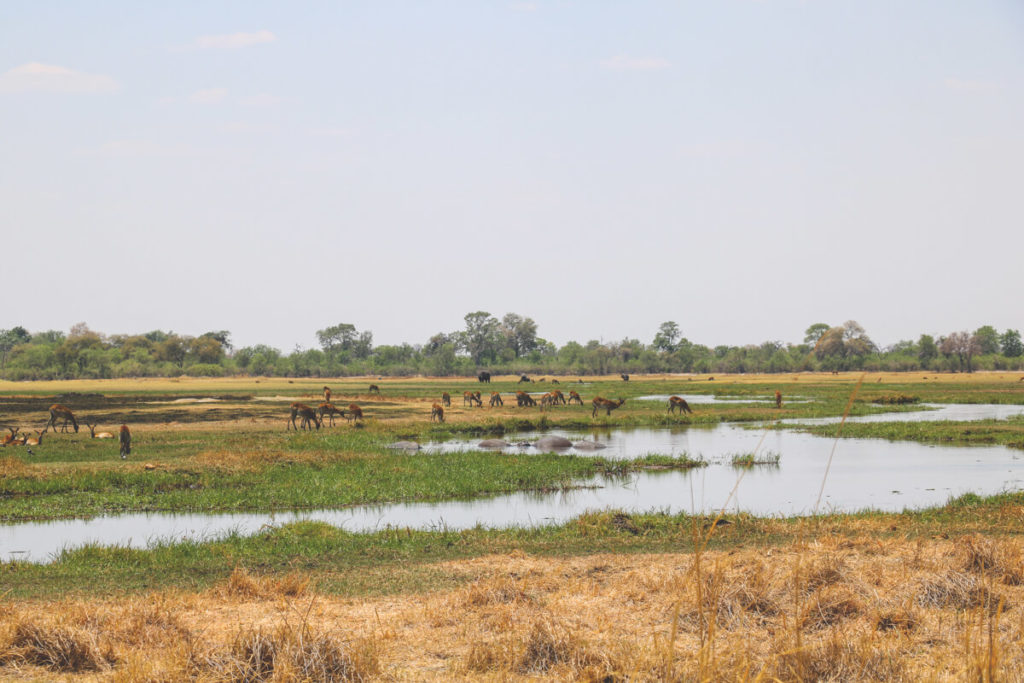
At some point, I spot a hyena about 10 meters from our fire. You could really see the disappointment in its eyes when we caught it. After a few more minutes, one suddenly appears out of the darkness in the camp, not three meters away from us. Okay, time to go to bed. I’m a lot more relaxed than last night, crouching in front of my tent window and keeping watch; unfortunately, the hyenas had lost interest too. Only a honey badger came into the camp and licked the toothpaste off the ground (once it’s dark, you don’t even need to think about running to the washroom; it’s far too dangerous, even if it’s only 10 meters away!). I sleep like a baby that night.
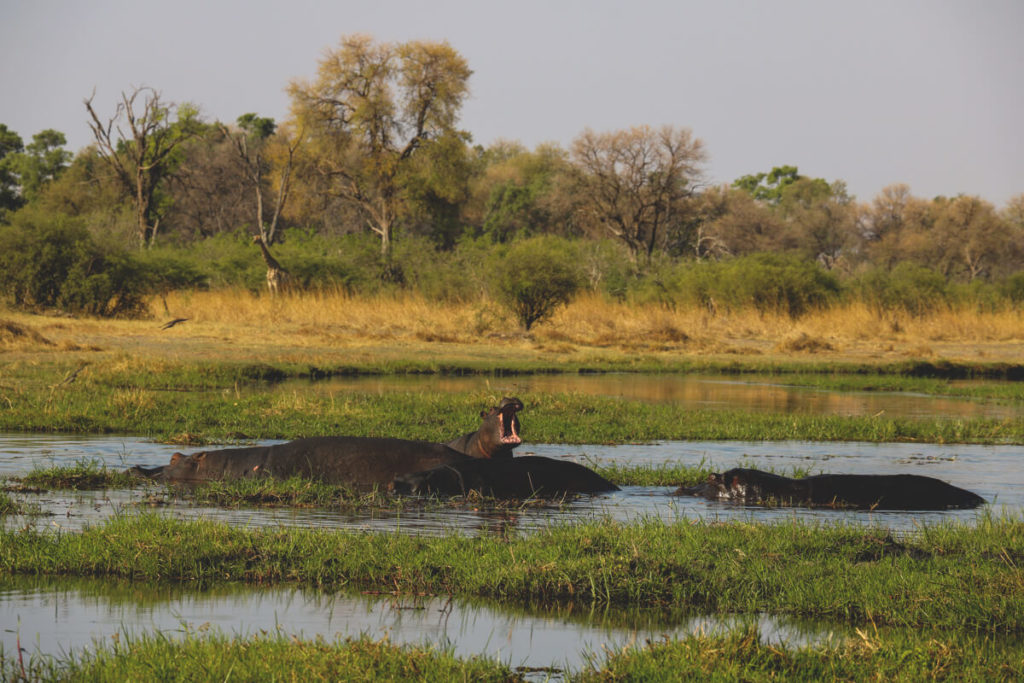

The Dqae Qare San Lodge
The next morning it’s time to say goodbye to the delta and continue on to Ghanzi to the Dqae Qare San Lodge. The San, Bushmen of the Kalahari, were granted human rights as part of the 2013 legislative change, but since then have been banned from living in the country’s national parks. Villages on the edge of the desert have not really come close to their Bushmen lives.
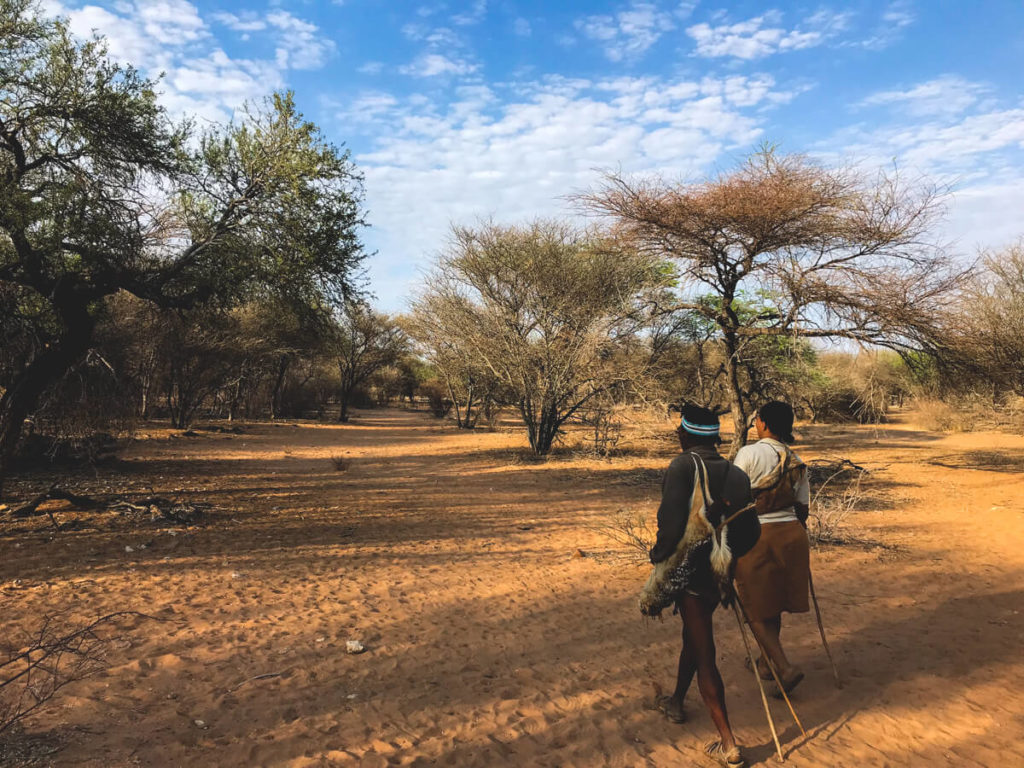
As a result, the Dutch government purchased several farms and combined them to form the Dqae Qare San Lodge. This land was given to the San Bushmen to protect and pass on their culture and bush way of life. Here, you can learn how to make fire in the bush or how to make various jewelry or ropes.
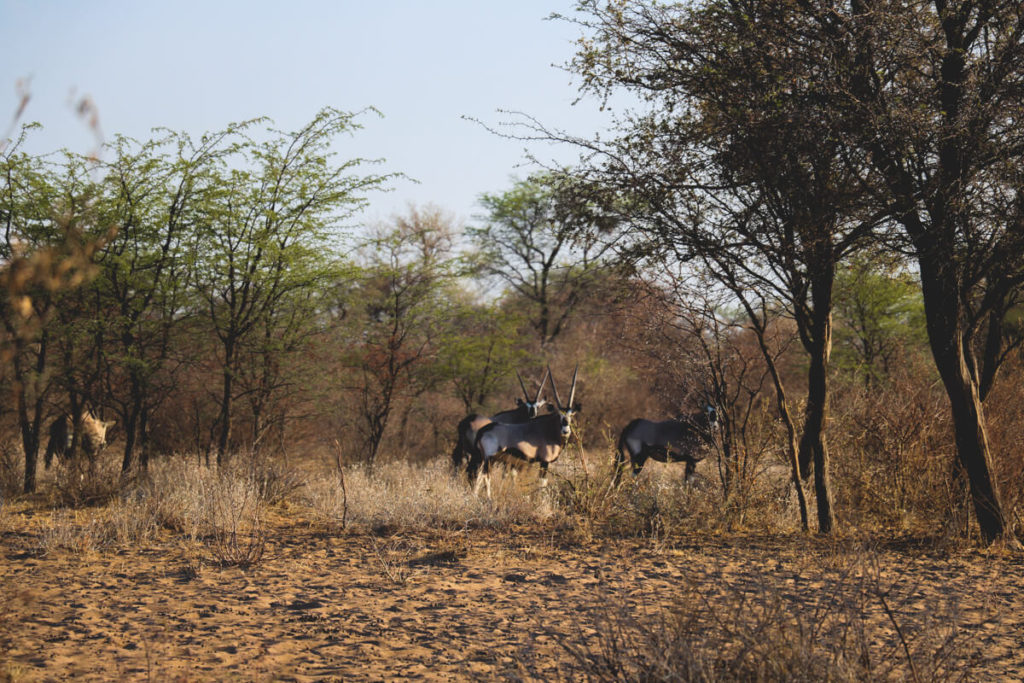
There are also various dance rituals and bushwalks that you can participate in. We were lucky that on the very evening we were here, a traditional dance and healing ritual was being performed, which we were able to attend. We also walked through the bush with the San one morning and learned various things about plants and animals. It’s quite impressive how, even in the worst of droughts, you can still tell plants apart and attribute certain healing properties to them. We spent two days at the lodge before heading to Windhoek.
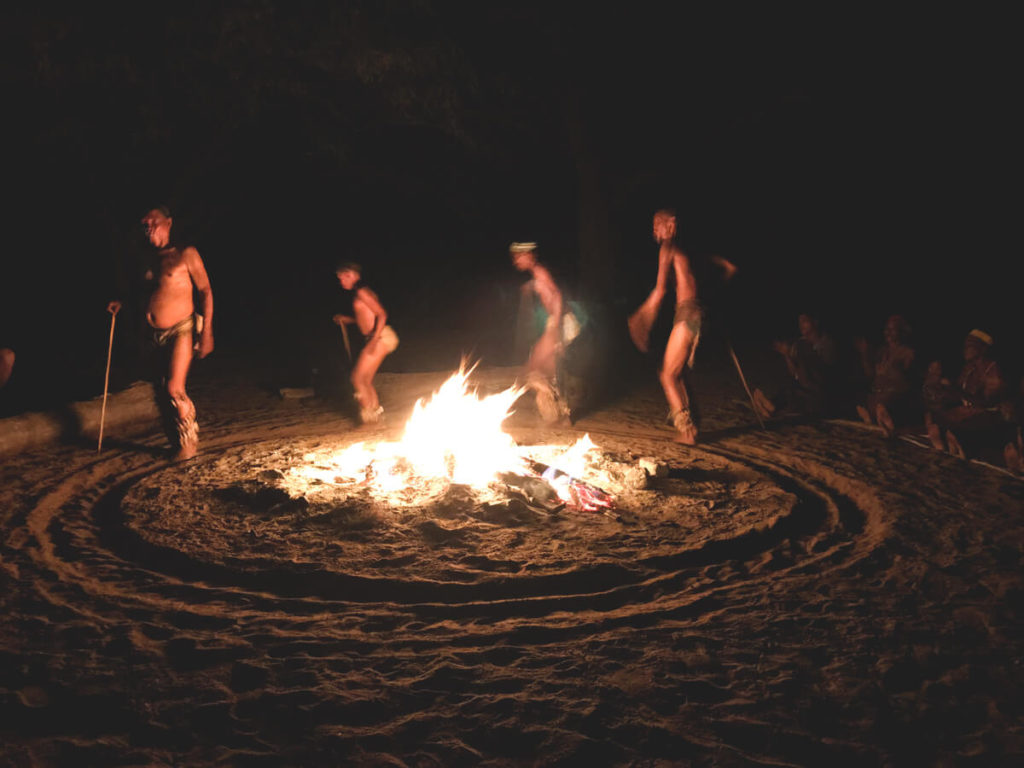
Saying Goodbye in Windhoek
In Windhoek, I said goodbye to the group. Of course, not without a visit to Joey’s Beerhouse and an extensive shopping spree through all the grocery stores, because they have the most amazing German delicacies. We stayed overnight at the Arebbusch Camping Lodge*. I traveled back to Cape Town via Intercape. The 22 hours on the bus, including the border crossing, went smoothly; I was even upgraded to the front row of the bus.
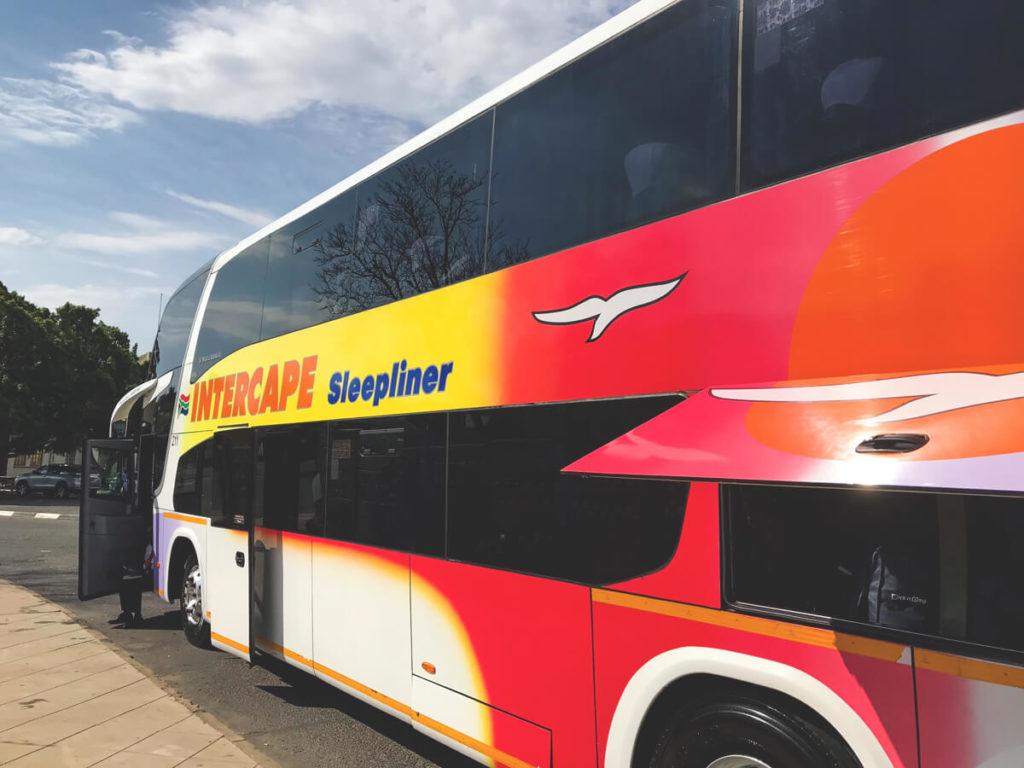
Camping and Tenting
Camping in Botswana is a bit more exciting than in other countries. Since there are no fences or barriers, you’re camping in the habitat of many wild animals. This may be exciting and thrilling (especially if you have a roof tent), but it’s also challenging, because there may be only a tarp between you and an animal.
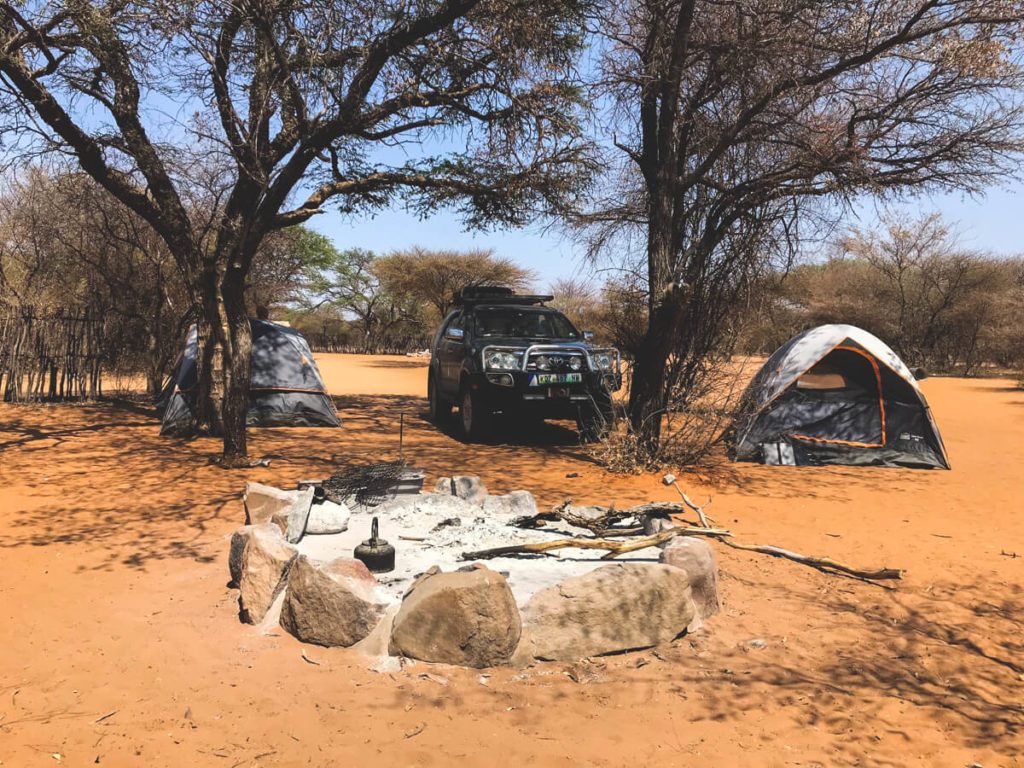
We traveled with small tents, each of which we slept in alone. At the beginning of our trip, we were still in fenced-in areas of the parks; in Botswana, you can encounter anything outside your tent at night. You should especially make sure to cook early in the evening so as not to draw unnecessary attention to the meat on your grill, as there are quite a few animals out and about at dusk.

After dark, you shouldn’t stray more than a few meters from the fire. It’s advisable to put a few logs on the fire before going to bed as a light source, so you can still see the animals from your tent (be careful during the dry season). Otherwise, you should always make sure to “baboon-proof” your car and camp, meaning lock and lock everything away. Even engine oil and a tire repair kit were stolen/eaten from our trailer.
Costs for the round trip through Botswana
Estimating the costs of the trip isn’t easy, as Piete, who owns the car, works as a tour guide and was therefore certainly able to snag a discount or two. The distance to the accommodations was 2,500km; including game drives, shopping, refueling, etc., we drove at least 3,600km. Here’s a brief breakdown of what I remember from memory and Google. The prices in euros were converted from other currencies in November 2019.
Please note that I didn’t have any rental costs for a car, as it was private. All in all, I have to say I was very lucky to have found this group. Had I driven alone in my own car or in a guided group, it would have easily cost me twice as much. Furthermore, I was traveling on a tight budget. A proper room in a lodge can easily cost the entire trip per night, especially if you’re heading toward the Okavango Delta.
Packing list for my Botswana tour
The packing list depends a bit on how you’re traveling. Do you have a camper with cooking and camping equipment (as in my case or in the case of a rental camper) or do you stay in lodges and sleep in a proper room? Even though I had full camping gear, I still had a sleeping bag, a camping wine glass, cutlery (fork-spoon combo), and a lunch box.
My tips for things you should have with you:
- Clothes (preferably not white, as they’ll never get clean again)
- Sweater for nighttime
- Sports clothes, comfortable for long car rides
- Swimsuits, in case there’s a pool
- Detergent for hand washing and clothesline use
- Toiletry bag:
- Especially important: hair conditioner, body lotion, lip balm, and face mask, as the salt and dryness can really take their toll on skin and hair
- Important: Sunscreen, mosquito repellent
- Solar panel for charging electronic devices
- Card games, books, binoculars, Camera
- Malaria test kit
Important things I would have liked to have had with me:
- More mosquito repellent
- Pocket knife
- Very good flashlight
- More books
- Even more mosquito repellent
Conclusion: Botswana tour
It was a wonderfully exciting Botswana tour. I would do it again and again. However, the temperatures and the dry, dreary landscape were quite tough on me. Next time, I would like to see the country in green; perhaps April (end of the rainy season) or May (beginning of the dry season) would be a good time for that.
Since I’ve heard from several sources that flying over the delta is worthwhile, I’ll consider it for my next trip (of course, I’ll try to offset the CO2 emissions). There’s less wildlife to see during the rainy season, but I’ve already seen a lot of animals on this trip and can focus on nature and the landscape next time.
